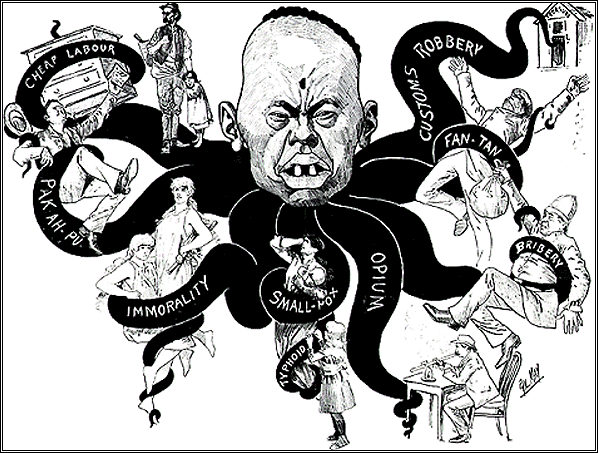 For the past month (at least) our neighbors have been renovating. The noise of electric saws and excessive hammering has woken me up almost all of those days and is often mixed with yelling. This morning was no different but somehow irritated me more than normal. I showered and left the house for a full day of museums.
For the past month (at least) our neighbors have been renovating. The noise of electric saws and excessive hammering has woken me up almost all of those days and is often mixed with yelling. This morning was no different but somehow irritated me more than normal. I showered and left the house for a full day of museums.My first stop was the Immigration Museum, which is located in the beautiful old Customs House. I had already known most of the general information from history classes so I was able to focus more on the specific details of various immigrants' journeys.
Quick timeline of significant events:

1788 Britain sends convicts to Sydney.
1848 First non-British ship of settlers comes from Germany.
1860 British agents paid to recruit unmarried women to Victoria.
1861 Legislation confines Aboriginals to reserves & missions.
1888 Chinese prevented from disembarking ships in Sydney and Melbourne.

1892 Colonial government restricts all non-European immigration.
1901 Federation of Australia.
1965 Labor Party removes the "White Australia Policy" from their platform.
1967 Aboriginals counted in census and governed by Federal legislation.
1993 Native Title Act recognizes Aboriginal rights to their land.
 The museum also had a spectacular exhibit about Hampi in southern India. In addition to hundreds of photos taken of ancient Hindu temples and beautiful ruins, there were a couple interactive rooms utilizing techniques I'd never seen before.
The museum also had a spectacular exhibit about Hampi in southern India. In addition to hundreds of photos taken of ancient Hindu temples and beautiful ruins, there were a couple interactive rooms utilizing techniques I'd never seen before.One room had a light table with photographs spread across the surface. Each photo had a barcode; when scanned, the slide projector would enlarge the photograph and show it on the wall with a description about the particular image.
Below image from UNSW iCinema Centre

Another room housed a circular screen with panoramic, 3D images of various sites. Visitors stand on a platform in the center of the room and move the projector to both choose which site they would like to visit as well as move around within that site. Other visitors can stand around the room and explore the 3D element of the video, sensing the depth of ancient temples and examining ruins.
Next up was the Australian Centre for the Moving Image. The current exhibit is about the history of technological advances in video. There was information about video games, early TV, cinema, YouTube and so on. Though the material may not sound incredibly new to many of my generation, the reason for visiting ACMI is often to experience the displays.
Highlights included a massive zoetrope, an interactive monster-making silhouette screen and a multi-camera sphere akin to The Matrix.
My favorite was Anthony McCall's You and I, H
 orizontal. Upon stepping into the dark room filled with fog machine haze and beams of light, you may not think it will be more than a few seconds of entertainment. After all, the light projection on the wall is just a simple outline of a geometric shape. So you take a few steps into the room and block part of the light. Your shadow breaks up the shape on the wall, but it also breaks up the beam of light traveling across the room. And as you continue to move through the beams you start to play more with the light. You can duck underneath the beams, try to block large portions, small portions, or just watch the swirls of fog traverse across the room. And if you wave your hand rapidly enough through the light, colors appear between your fingers.
orizontal. Upon stepping into the dark room filled with fog machine haze and beams of light, you may not think it will be more than a few seconds of entertainment. After all, the light projection on the wall is just a simple outline of a geometric shape. So you take a few steps into the room and block part of the light. Your shadow breaks up the shape on the wall, but it also breaks up the beam of light traveling across the room. And as you continue to move through the beams you start to play more with the light. You can duck underneath the beams, try to block large portions, small portions, or just watch the swirls of fog traverse across the room. And if you wave your hand rapidly enough through the light, colors appear between your fingers.T
 he third and final museum of the day was the Ian Potter Centre: National Gallery of Victoria Australia. The collection of work by Australian artists ranges across time periods, genre and artist backgrounds. It covers immigrant settlers' work as well as Aboriginal sculptures and paintings.
he third and final museum of the day was the Ian Potter Centre: National Gallery of Victoria Australia. The collection of work by Australian artists ranges across time periods, genre and artist backgrounds. It covers immigrant settlers' work as well as Aboriginal sculptures and paintings.The architecture is quite impressive as well. Some art museums attempt to be works of art on their own, and it doesn't always work, but this one does. Placed inside Federation Square, the sharp-angled windows mimic the rest of the building and frame highlights of the cityscape, turning the city into a piece of art itself.












































